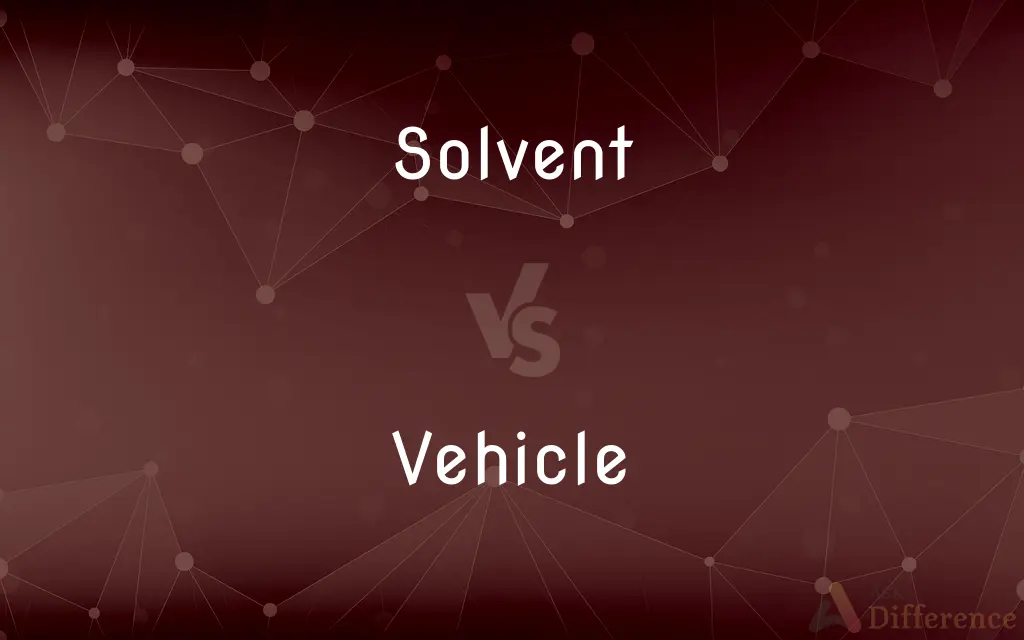Solvent vs. Vehicle — What's the Difference?
Edited by Tayyaba Rehman — By Urooj Arif — Updated on March 8, 2024
A solvent is substance that dissolves a solute, forming solution, often used in chemical and pharmaceutical processes, while vehicle is carrier or base in which substance is diluted or suspended for application, particularly in pharmacology and cosmetics.

Difference Between Solvent and Vehicle
Table of Contents
ADVERTISEMENT
Key Differences
Solvents are critical in both industrial and laboratory settings for dissolving solutes to create solutions. These can be organic, like ethanol or acetone, or inorganic, such as water, each chosen based on their ability to dissolve specific solutes. Their main function is to alter the physical state of a substance without changing its chemical composition. Vehicles, however, serve a broader purpose, acting as the medium or base in which active ingredients are dissolved or dispersed for administration or application. Vehicles ensure that the active ingredients are effectively delivered in a usable form, such as liquids for injections or creams for topical application.
The choice of solvent depends on the chemical properties of both the solvent and the solute, including polarity, to ensure proper dissolution. In contrast, the selection of a vehicle is based on the desired consistency, absorption rate, and method of delivery of the final product, taking into account the therapeutic context and the target tissue or system. For example, water might be used as a solvent to dissolve salts in a laboratory, while a cream base serving as a vehicle might be selected for its ability to deliver a topical steroid to the skin.
Solvents often play a pivotal role in chemical reactions and the manufacturing of products by enabling substances to interact in a homogeneous solution. Vehicles, on the other hand, are crucial in the formulation of pharmaceuticals, cosmetics, and other products intended for human use, focusing on the safe and effective delivery of active ingredients.
Safety and environmental impact considerations also differentiate solvents from vehicles. Many solvents are volatile organic compounds (VOCs) and require careful handling due to their potential health and environmental risks. Vehicles are typically selected for their compatibility with the body or skin and are generally formulated to minimize irritation and maximize patient or consumer comfort.
Comparison Chart
Definition
A substance that dissolves a solute to form a solution
A carrier or base for delivering active substances
ADVERTISEMENT
Primary Use
Dissolving, extracting, and facilitating reactions
Delivering medications, cosmetics, or other substances
Examples
Water, ethanol, acetone
Creams, gels, oils, solutions for injections
Selection Criteria
Polarity, solubility, boiling point
Consistency, absorption, method of delivery, safety
Role in Products
Enables substances to interact in a solution
Ensures effective delivery and application of products
Safety Considerations
Often volatile and flammable, requires careful handling
Formulated for safety and compatibility with application
Compare with Definitions
Solvent
Can be organic or inorganic.
Organic solvents include benzene and chloroform.
Vehicle
Selected based on the delivery method and formulation requirements.
Injectable medications use sterile aqueous solutions as vehicles.
Solvent
Solvents dissolve solutes to create solutions.
Ethanol is used as a solvent in pharmaceutical formulations.
Vehicle
Vehicles are carriers for active ingredients in formulations.
Lotions serve as vehicles in topical medications.
Solvent
Their volatility and flammability necessitate cautious handling.
Solvent vapors require proper ventilation to mitigate inhalation risks.
Vehicle
Designed to minimize irritation and enhance patient comfort.
Eye drops use specially formulated vehicles that are gentle on the eye.
Solvent
They are chosen based on their chemical compatibility with the solute.
Water, a universal solvent, dissolves many ionic compounds.
Vehicle
Aim to enhance the stability and efficacy of the active ingredient.
Oil-based vehicles are used for lipid-soluble vitamins.
Solvent
Critical in chemical synthesis and analysis.
Acetone is a common solvent in organic chemistry laboratories.
Vehicle
Important in pharmaceuticals and cosmetics for application ease.
Gels are used as vehicles for transdermal drug delivery.
Solvent
A solvent (from the Latin solvō, "loosen, untie, solve") is a substance that dissolves a solute, resulting in a solution. A solvent is usually a liquid but can also be a solid, a gas, or a supercritical fluid.
Vehicle
A vehicle (from Latin: vehiculum) is a machine that transports people or cargo. Vehicles include wagons, bicycles, motor vehicles (motorcycles, cars, trucks, buses), railed vehicles (trains, trams), watercraft (ships, boats), amphibious vehicles (screw-propelled vehicle, hovercraft), aircraft (airplanes, helicopters) and spacecraft.Land vehicles are classified broadly by what is used to apply steering and drive forces against the ground: wheeled, tracked, railed or skied.
Solvent
Capable of meeting financial obligations.
Vehicle
A thing used for transporting people or goods, especially on land, such as a car, lorry, or cart
The vehicle was sent skidding across the road
A heavy goods vehicle
Solvent
(Chemistry) Capable of dissolving another substance.
Vehicle
A thing used to express, embody, or fulfil something
I use paint as a vehicle for my ideas
Solvent
A substance in which another substance is dissolved, forming a solution.
Vehicle
A film, television programme, song, etc. that is intended to display the leading performer to the best advantage
A vehicle for a star who was one of Hollywood's hottest properties
Solvent
A substance, usually a liquid, capable of dissolving another substance.
Vehicle
A privately controlled company through which an individual or organization conducts a particular kind of business, especially investment.
Solvent
Something that solves or explains.
Vehicle
A device or structure for transporting persons or things; a conveyance
A space vehicle.
Solvent
A fluid that dissolves a solid, liquid, or gaseous solute, resulting in a solution.
Vehicle
A self-propelled conveyance that runs on tires; a motor vehicle.
Solvent
That which resolves.
Vehicle
A medium through which something is transmitted, expressed, or accomplished
His novels are a vehicle for his political views.
Solvent
(finance) Able to pay all debts as they become due, and having no more liabilities than assets.
Vehicle
The concrete or specific word or phrase that is applied to the tenor of a metaphor and gives the metaphor its figurative power, as walking shadow in "Life's but a walking shadow" (Shakespeare).
Solvent
Having the power of dissolving; causing solution.
Vehicle
A play, role, or piece of music used to display the special talents of one performer or company.
Solvent
Having the power of dissolving; dissolving; as, a solvent fluid.
Vehicle
An inactive substance that is combined with an active medication to facilitate administration.
Solvent
Able or sufficient to pay all just debts; as, a solvent merchant; the estate is solvent.
Vehicle
A substance, such as oil, in which paint pigments are mixed for application.
Solvent
A substance (usually liquid) suitable for, or employed in, solution, or in dissolving something; as, water is the appropriate solvent of most salts, alcohol of resins, ether of fats, and mercury or acids of metals, etc.
Vehicle
A conveyance; a device for carrying or transporting substances, objects or individuals.
Solvent
That which resolves; as, a solvent of mystery.
Vehicle
A medium for expression of talent or views.
Supporting actors in a Steven Spielberg vehicle
Solvent
A liquid substance capable of dissolving other substances;
The solvent does not change its state in forming a solution
Vehicle
A liquid content (e.g. oil) which acts as a binding and drying agent in paint.
Solvent
A statement that solves a problem or explains how to solve the problem;
They were trying to find a peaceful solution
The answers were in the back of the book
He computed the result to four decimal places
Vehicle
(pharmaceuticals) The main excipient (such as an oil or gel) that conveys the active ingredient of a drug.
An ointment with a petrolatum vehicle
Solvent
Capable of meeting financial obligations
Vehicle
An entity to achieve an end.
Mission service as a vehicle for development of better-rounded worldviews
Vehicle
(Buddhism) A mode or method of spiritual practice; a yana.
Vehicle
(Hinduism) An animal or (rarely) a plant on which a Hindu deity rides or sits
Vehicle
That in or on which any person or thing is, or may be, carried, as a coach, carriage, wagon, cart, car, sleigh, bicycle, etc.; a means of conveyance; specifically, a means of conveyance upon land.
Vehicle
That which is used as the instrument of conveyance or communication; as, matter is the vehicle of energy.
A simple style forms the best vehicle of thought to a popular assembly.
Vehicle
A substance in which medicine is taken.
Vehicle
Any liquid with which a pigment is applied, including whatever gum, wax, or glutinous or adhesive substance is combined with it.
Vehicle
A liquid used to spread sensitive salts upon glass and paper for use in photography.
Vehicle
A conveyance that transports people or objects
Vehicle
A medium for the expression or achievement of something;
His editorials provided a vehicle for his political views
A congregation is a vehicle of group identity
Vehicle
Any inanimate object (as a towel or money or clothing or dishes or books or toys etc.) that can transmit infectious agents from one person to another
Common Curiosities
What is a solvent?
A solvent is a substance that can dissolve other substances (solutes), forming a homogeneous solution, used widely in chemical processes and product formulations.
Can water act as both a solvent and a vehicle?
Yes, water can serve as both a solvent in dissolving substances for chemical reactions and as a vehicle in formulations for delivering active ingredients.
What is a vehicle?
A vehicle is a base or carrier used to deliver active ingredients in a formulation, ensuring effective application and absorption, especially in pharmaceuticals and cosmetics.
How do I choose the right solvent?
The right solvent is selected based on its ability to dissolve the intended solute, considering factors like polarity and solubility.
Are solvents always liquid?
While solvents are typically liquid, some processes may use supercritical fluids or gases as solvents under specific conditions.
What role do vehicles play in pharmaceuticals?
Vehicles ensure that medications are delivered in a form that is easy to administer, effective, and safe, considering the route of administration and target tissue.
Can a single formulation use multiple vehicles?
Yes, complex formulations may use multiple vehicles to optimize the delivery and efficacy of different active ingredients.
Why is the choice of solvent important in reactions?
The choice of solvent can influence the rate, direction, and yield of chemical reactions, affecting the efficiency and outcome of the process.
How do environmental concerns affect solvent use?
Due to their volatility and potential toxicity, the use and disposal of solvents are regulated to minimize environmental and health risks.
What makes a good vehicle for topical applications?
A good vehicle for topical applications enhances the active ingredient's penetration, spreads easily, and minimizes skin irritation.
What is the impact of solvent polarity on solubility?
Solvent polarity affects solubility by determining how well it can dissolve polar or non-polar solutes, based on the "like dissolves like" principle.
What considerations are important when selecting a vehicle?
When selecting a vehicle, consider the formulation's desired consistency, method of delivery, target area or system, and safety for the intended use.
How are vehicles chosen for injectable medications?
Vehicles for injectables are chosen based on sterility, compatibility with the body, and the ability to maintain the stability of the active ingredient.
Why is vehicle compatibility important in formulations?
Vehicle compatibility is crucial for maintaining the stability, efficacy, and safety of the formulation, ensuring that the active ingredients are delivered effectively.
What safety measures should be taken when handling solvents?
Use appropriate personal protective equipment (PPE), ensure good ventilation, and follow storage and disposal guidelines to handle solvents safely.
Share Your Discovery

Previous Comparison
Scarf vs. Snarf
Next Comparison
Diploblastic vs. TriploblasticAuthor Spotlight
Written by
Urooj ArifUrooj is a skilled content writer at Ask Difference, known for her exceptional ability to simplify complex topics into engaging and informative content. With a passion for research and a flair for clear, concise writing, she consistently delivers articles that resonate with our diverse audience.
Edited by
Tayyaba RehmanTayyaba Rehman is a distinguished writer, currently serving as a primary contributor to askdifference.com. As a researcher in semantics and etymology, Tayyaba's passion for the complexity of languages and their distinctions has found a perfect home on the platform. Tayyaba delves into the intricacies of language, distinguishing between commonly confused words and phrases, thereby providing clarity for readers worldwide.
















































